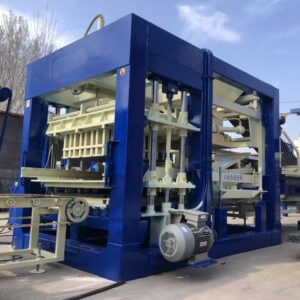
In the realm of construction, efficiency and precision stand as cornerstones for successful projects.
As the demands of modern architecture continue to evolve, so does the technology that supports it.
The advent of high-performance block machines has revolutionized the construction industry, enabling rapid and precise building processes that were once inconceivable.
This essay delves into the capabilities, advantages, challenges, and future prospects of these advanced block machines, which have become pivotal in shaping the way we construct buildings.
The Evolution of High-Performance Block Machines
The journey of block machines began with rudimentary designs that required significant manual intervention.
As the need for faster and more accurate construction techniques arose, engineers and innovators ventured into the development of automated block machines.
These early iterations marked the starting point of a technological revolution that aimed to enhance the construction process.
With the advancement of robotics, material science, and computer-aided design, the first high-performance block machines emerged.
These machines incorporated intricate mechanisms to handle various types of construction materials, ranging from concrete to lightweight aggregate blocks.
The integration of precise sensors and programmable logic controllers (PLCs) brought about a paradigm shift, enabling machines to produce uniform blocks with minimal wastage.
Capabilities and Advantages
The high-performance block machines of today offer an impressive array of capabilities that have transformed the construction landscape:
Speed and Efficiency: Perhaps the most remarkable feature of these machines is their ability to produce a large number of blocks in a fraction of the time it would take using traditional methods.
This boost in speed accelerates project timelines and reduces labor costs significantly.
Precision and Consistency: High-performance block machines operate with a level of precision that human hands simply cannot replicate consistently.
Each block is manufactured to exact specifications, ensuring uniformity in dimensions and structural integrity.
Versatility: These machines are designed to accommodate various block sizes, shapes, and compositions, catering to the diverse needs of construction projects.
Whether it’s load-bearing blocks or aesthetically intricate designs, the versatility of these machines is a testament to their engineering prowess.
Labor Reduction: By automating the block-making process, the need for extensive manual labor is greatly reduced.
This not only minimizes the physical strain on workers but also addresses labor shortages that can hinder construction progress.
Waste Reduction: High-performance block machines optimize material usage, resulting in minimal waste generation.
This not only contributes to cost savings but also aligns with sustainable construction practices.
Challenges and Innovations
Despite their many advantages, high-performance block machines are not without challenges:
Initial Investment: The cost of acquiring and installing these advanced machines can be substantial, which might deter some smaller construction firms from adopting them.
Maintenance and Training: Ensuring the seamless operation of these machines requires specialized training for personnel and regular maintenance to keep them functioning optimally.
Material Compatibility: Different construction materials have varying properties, and optimizing the machine’s settings for each material can be complex.
Innovations are ongoing to create machines that can handle a wider range of materials with minimal adjustments.
However, these challenges have spurred innovations in the field. Manufacturers are working to develop cost-effective models that are easier to maintain and operate.
Additionally, advancements in artificial intelligence and machine learning are being integrated to enhance machine diagnostics, predict maintenance needs, and optimize block production parameters.
Future Prospects and Implications
Looking ahead, the future prospects of high-performance block machines are exceptionally promising:
Smart Integration: The fusion of Internet of Things (IoT) technology with block machines is on the horizon.
This will enable remote monitoring, real-time data analysis, and predictive maintenance, leading to even more efficient and uninterrupted operations.
Sustainable Construction: The emphasis on sustainability in the construction industry is likely to drive the development of block machines that utilize recycled materials and generate fewer emissions during operation.
Customization: As architectural designs become more intricate and personalized, block machines will need to adapt to produce highly customized blocks that align with unique project requirements.
Global Impact: High-performance block machines have the potential to revolutionize construction practices in developing countries, where efficient and affordable building solutions are crucial for infrastructural growth.
The journey from manual block-making techniques to the high-performance block machines of today has been marked by a relentless pursuit of efficiency, precision, and innovation.
These machines have transformed construction processes, enabling the creation of structures that are not only built faster but also with unparalleled accuracy.
Challenges remain, but the ongoing innovations in this field hold the promise of a future where construction is seamlessly integrated with cutting-edge technology, reshaping skylines and communities around the world.
As we continue to unveil the potential of high-performance block machines, we simultaneously unveil a more efficient and sustainable future for the construction industry.
